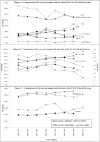Spinal cord injury community survey: a national, comprehensive study to portray the lives of canadians with spinal cord injury
- PMID: 25477739
- PMCID: PMC4252126
- DOI: 10.1310/sci2004-249
Spinal cord injury community survey: a national, comprehensive study to portray the lives of canadians with spinal cord injury
Abstract
Background: To better understand service-related needs and the current situation of persons with spinal cord injury (SCI) living in the community, a more comprehensive approach for studying their interrelationships (needs vs community living outcomes) is greatly needed.
Objective: To describe the development, design, and findings of a Canadian survey portraying the life situation of people with SCI.
Method: The SCI Community Survey covers demographics, health, SCI-specific needs, community participation, employment, quality of life, health care utilization, and overall health rating. A total of 1,549 persons with SCI completed the survey (Web or phone) between May 2011 and August 2012.
Results: Some major expressed needs for services to support community living are met to a great extent for a substantial proportion of people with SCI. Complications remain highly prevalent for some health issues, including pain, sexual dysfunction, and musculoskeletal disorders. The extent of community participation based on values and preferences varies tremendously among daily activities and social roles. Some dimensions of quality of life are rated positively (eg, family life) while others are greatly disrupted (eg, sex life and physical health). Most of these findings vary significantly between people with traumatic and nontraumatic lesions.
Conclusion: This survey is the first in Canada and among the first worldwide to draw a comprehensive picture of major aspects of the lives of people with SCI including service needs. The results will help to determine the links between various aspects of community living and guide service providers and policy makers in focusing on major issues to enhance quality of life after SCI.
Keywords: SCI-related needs; community living; quality of life; secondary health conditions; social participation; spinal cord injury.
Figures




References
-
- United Nations Convention on the Rights of Persons with Disabilities. http://www.un.org/disabilities/convention/conventionfull.shtml2006. - PubMed
-
- World Health Organization. World report on disability. http://www.who.int/disabilities/world_report/2011/report/en/2011.
-
- Heinemann AW, Sokol K, Garvin L, Bode RK.Measuring unmet needs and services among persons with traumatic brain injury. Arch Phys Med Rehabil. 2002;83(8):1052–1059. - PubMed
-
- Kennedy P, Lude P, Taylor N.Quality of life, social participation, appraisals and coping post spinal cord injury: A review of four community samples. Spinal Cord. 2006;44(2):95–105. - PubMed
-
- Cox RJ, Amsters DI, Pershouse KJ.The need for a multidisciplinary outreach service for people with spinal cord injury living in the community. Clin Rehabil. 2001;15(6):600–606. - PubMed
LinkOut - more resources
Full Text Sources
Other Literature Sources
Miscellaneous
